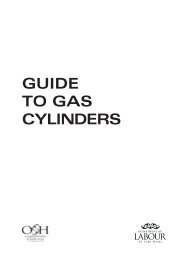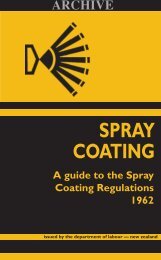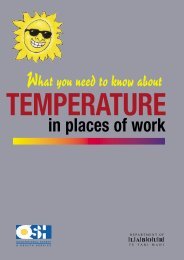Underground Petroleum Storage Tanks and Related Wastes - Code ...
Underground Petroleum Storage Tanks and Related Wastes - Code ...
Underground Petroleum Storage Tanks and Related Wastes - Code ...
Create successful ePaper yourself
Turn your PDF publications into a flip-book with our unique Google optimized e-Paper software.
In addition, any person entering a confined space must wear safety harness <strong>and</strong><br />
safety rope, <strong>and</strong> be attended by a second person watching over him/her from<br />
outside the tank, with breathing apparatus at h<strong>and</strong>. At least one other person must<br />
be available, within call, to assist should it be necessary.<br />
A Confined Space Entry Permit is shown in appendix 10.<br />
11.13 Tank Cleaning<br />
Once entry has been gained, the tank should be cleaned internally of any remaining<br />
waxes <strong>and</strong> sludge. The external surfaces should also be cleaned in preparation<br />
for cutting into manageable sections. Continue to cut the tank steel into appropriately<br />
sized sections for subsequent removal to an approved furnace operation for<br />
melting down.<br />
The internal surfaces of the tank should only be h<strong>and</strong>led when wearing gloves.<br />
Additional protection such as a barrier cream applied to the h<strong>and</strong>s may also be<br />
used.<br />
11.14 Scrap Tank Materials<br />
Scrap steel cut from the tank must be flame cleaned or grit/shot blasted as set out<br />
in Octel Instruction Publication No. 5-01/92, before being released from the site.<br />
Any scale generated by cleaning operations <strong>and</strong> any other scrap materials from the<br />
tank must be collected <strong>and</strong> treated as hazardous waste.<br />
All storage, movement <strong>and</strong> disposal of scrap materials must be documented, as for<br />
hazardous wastes. See section 12: Treatment <strong>and</strong> Disposal of Hazardous Waste.<br />
12. TREATMENT AND DISPOSAL OF HAZARDOUS WASTES<br />
12.1 Responsibility <strong>and</strong> Legal Requirements<br />
It is m<strong>and</strong>atory for all parties involved in the cleaning of petroleum tanks to ensure<br />
that the disposal of the residual hazardous wastes, e.g. leaded sludge <strong>and</strong> scale, or<br />
scrap tank materials, is not in breach of local or central government regulations<br />
applicable in the area where the operation is taking place.<br />
Compliance with these requirements is the responsibility of the contractor.<br />
12.2 Description of Leaded <strong>Petroleum</strong> Sludge<br />
The residue remaining in leaded petrol storage tanks after all recoverable petrol<br />
has been removed consists of liquid <strong>and</strong> solid matter. It is poisonous. Any tank<br />
that has been used to store leaded product at any time must be considered a lead<br />
hazard.<br />
All lead compounds are toxic, <strong>and</strong> organic lead compounds are particularly poisonous.<br />
They can be absorbed by breathing the vapour or dust, by swallowing dust<br />
or dirt from face or h<strong>and</strong>s, or by direct absorption through the skin.<br />
The liquid consists of two phases:<br />
• Water containing dissolved lead salts <strong>and</strong> some organic matter; <strong>and</strong><br />
• Hydrocarbons floating on the water.<br />
The solids, formed mainly by the rusting of the steel tank, consist of a mixture of<br />
iron oxides, water, petrol <strong>and</strong>, inorganic <strong>and</strong> organic lead compounds.<br />
The following is a typical analysis:<br />
Transport <strong>and</strong> Disposal of <strong>Petroleum</strong> <strong>Storage</strong> <strong>Tanks</strong> 23





